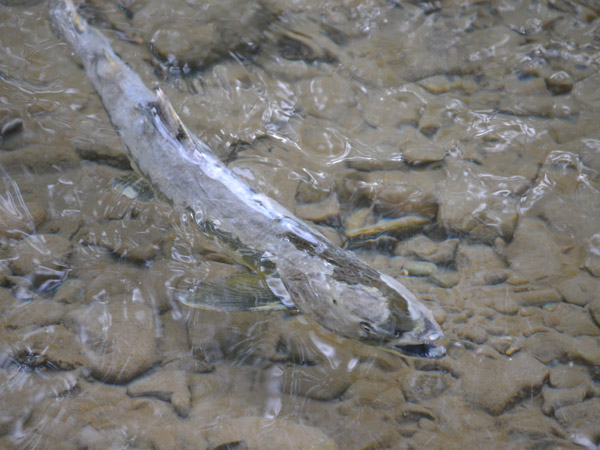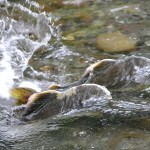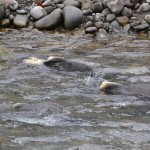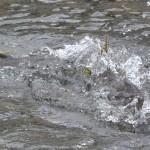Humpback or pink salmon have been swimming up the Dungeness River to spawn in record numbers this year. The director of our local Dungeness River Audubon Center has declared it the biggest run in 10 years and estimates that there may be a run of as many as 60,000 fish, possibly more.
The fish average about four to five pounds in size. The one pictured above was about 14-16 inches. They must swim through fast-running currents and expend a tremendous amount of energy to reach spots where they lay or fertilize eggs for the next generation of salmon.
Females lay about 3,000 eggs each and the males, called bucks, fertilize them as they swim over the eggs. The bucks spawn until they die and the river is littered with fish carcasses. It’s a credit to the relative health of local rivers that runs like this occur. Salmon need clean waters and gravel beds, with vegetation cover to keep the waters cool. Erosion from road and home-building can load waters with sediment and runoff from garden chemicals or livestock waste can pollute rivers and streams and devastate a fishery.




I am so glad to see y’all are having a good run this year! That is awesome! I watched a show about salmon conservation and recovery and it seemed that all of their efforts were hit ‘n’ miss. It is awesome to know that all of that care and attention is paying off!
During our visit to Sequim early this month, we spent some time on the Dungeness River Bridge at the Audubon Center watching the spawning salmon. I had overheard someone earlier that AM talking about the spawning and went to see for ourselves. Amazing site!
It certainly is a credit to the quality of your rivers around those parts! But tell me, if the male spawns, then dies, is his carcass no good for eating? Why do the carcasses rot on the sides of the river? Why arent they being scooped up for the evening meal?
Julie, I’m sure there are plenty of critters that would feed on the dead fish. But if the numbers of spawning fish are as high as estimated, I would guess that there are more than enough to go around and the ones that rot are the “leftovers.” I did see picked-over fish skeletons when I was photographing, so I know that they are being eaten.
Kay, this is wonderful! Thank you for researching and filiming this for us. I am so glad to see that the spawning numbers are up. I hope that is true for all of the Clallam rivers.
Have you heard anything about what is expected on the Elwah this year while the dams are undergoing deconstruction?
Kibz, there is so much going on with the Elwah River dams. The long term plans include extensive native plant revegetation and there has been controversy about restocking the river using hatchery fish since they are not a strictly native species. It may be years before the full impact of the project is actually realized. I’ve not followed it carefully. Here’s an interesting link to videocams that are recording the dam deconstructions: http://www.video-monitoring.com/construction/olympic/js.htm.